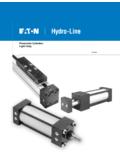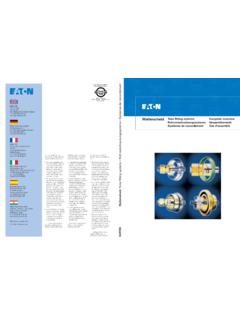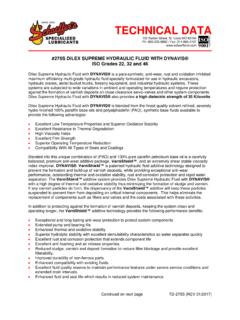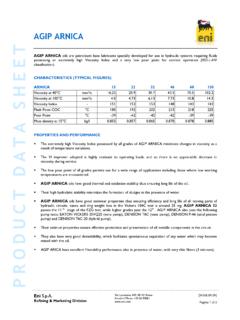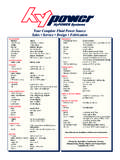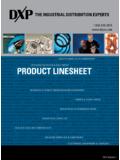Transcription of Hydro-Mechanical TORQUE CONTROL - Eaton
1 Today s diesels used in mid-size, off-road and construction equipment are clean, effi cient power sources, but they are far from indestructible. Stalling a turbocharged diesel is to be avoided at all costs and carries with it a high probability of cooking the turbo-charger lubricant. It may also cause the unit to self-destruct when the engine is re-started, a reason why engine builders include a mandatory cool-down period in the normal shutdown most functions on these types of machines are hydraulically powered, OEMs have turned to hydraulic suppli-ers for solutions.
2 One approach that has been successful on large equipment is the use of a pump equipped with an auto-matic Hydro-Mechanical TORQUE CONTROL system to limit the amount of TORQUE extracted from the engine. The idea here is to limit the TORQUE at the pump shaft across a wide range of engine speeds, says Todd McIntyre, product manager for Eaton Corp. It s the mirror image of a power CONTROL sys-tem that limits the amount of power at a fi xed speed. The OEM essentially has to choose which engine parameter they want to optimize, and if it s TORQUE then this is the answer.
3 For compact and mid-size equipment it is almost always TORQUE that needs to be controlled, McIntyre adds. The problem was that, until now, such a sys-tem was not readily available on pumps in this size range. An example of the pump s impact is in a telehandler application with engine specifi cations of 50 hp, 2,650 rpm and 1,194 inch-lb of TORQUE . Designed with-out TORQUE CONTROL , in order to lift with 3,000 psi, the design requires a cid (41 cc) 420 pump and fl ow is limited to 29 gpm even for light using TORQUE CONTROL , the engineer is able to specify a cid pump, and the larger displacement allows greater fl ow (faster operation) of the bucket when empty or not lifting with 3,000 psi.
4 Engaging TORQUE CONTROL and de-stroking the pump to cid pre-vents engine stalls with heavy new Eaton 420 Series pump with Hydro-Mechanical TORQUE CONTROL is essentially an enhanced version of a stan-dard pressure-compensated pump using a mechanical feedback loop to CONTROL swash plate position. In simple terms, the pressure compensator setting is varied according to swash plate position rather than acting at a single set point. Since TORQUE is a function of pressure and dis-placement, TORQUE is now held constant. The mechanical feedback determines the amount of fl ow the pump can deliver at a given pressure, because the pressure Hydro-Mechanical TORQUE CONTROLPump uses TORQUE to limit power, optimize diesel engine performanceBY AL PRESHER, CONTRIBUTING EDITORHigh load bearingZero leak technologyresults in higherefficiencyLoad sense compensatorEaton 420 Pump with Hydro-Mechanical TORQUE ControlHydro- mechanical torquecontrols limits maximumtorque back on an engine by decreasing flow in highpressure situations.
5 Andpreventing engine stallsAdjustable maximum TORQUE level allows CONTROL to be tuned to exact application and optimize efficiencyCompact designfits in tight spacesThe stable and fast response of the Eaton 420 pump is achieved by careful design of a Hydro-Mechanical proportional TORQUE CONTROL that limits fl ow to the CONTROL piston. The responsiveness of the CONTROL is improved with the help of a variable gain meth-odology which provides higher CONTROL fl ows to reach the desired TORQUE limit and then smaller fl ows to maintain the TORQUE level.
6 The result is minimized swash plate oscillation and TORQUE ripple which increases responsiveness and stability while reduc-ing noise and wear. SOURCE: Eaton Power/Power TransmissionTORQUE CONTROLF8 FLUID POWER/POWER TRANSMISSION / A SUPPLEMENT TO DESIGN NEWS MAY 2010 [ ] 85/4/2010 2:03:23 PM5/4/2010 2:03:23 PMdetermines the swash plate angle. In practical terms, that means the 420 pump will not extract more than a fi xed amount of TORQUE from the engine, McIntyre says. An added benefi t is faster function speeds when the work load is low because the fl ow rate changes.
7 He cites the example of how raising a backhoe bucket fi lled with concrete might happen slowly due to the TORQUE CONTROL setting protecting against engine stall. But if the operator empties the bucket, it will move faster because the fl ow rate will be higher. Curling a bucket at 20 gpm can require 10 to 15 more engine horsepower than curling the same bucket at 17 gpm on a small machine, he same amount of engine TORQUE is available in both cases because the pump automatically limits the TORQUE used no matter what the demand.
8 It will not stall the engine, regardless of what the opera-tion may on customer input, McIntyre says Eaton engineers chose to utilize a mechanical feedback system for the new 420 pump. The mechanical system provides the functionality required by today s equipment at a lower cost than a comparable electronic solution, McIntyre notes. He says the next generation of machines will almost certainly need electronic controls. But by then, new emissions requirements will be in place and the engines will already have extensive electronic management systems.
9 It makes good sense to tie the pump CONTROL into the same system, he adds. It s yet another example of the emer-gence of electro-hydraulic solutions as the wave of the future. For the present, though, Eaton s hy-dro- mechanical solution offers a number of advantages to OEMs in addition to controlling TORQUE . In some cases, it can help them keep their equipment from migrating into operating areas covered by tighter emission regulations. At the moment, a piece of equip-ment with a 68 hp engine falls under a different set of emission requirements than the same piece of equipment would with a 75 hp engine, McIntyre says.
10 If the OEM can provide the necessary machine functionality with the smaller engine by using a 420 pump to CONTROL TORQUE , they potentially can reduce their exposure to additional costs associated with more stringent standards. This factor will likely become increas-ingly important as new regulatory require-ments impact the power density of diesels. For example, being able to stay with the smaller engine could mean avoiding the cost of re-designing engine mounts, cool-ing arrangements and engine compart-ment geometry. Beyond that, the pumps themselves are more durable because bearing loads are constant across the whole operating range.










